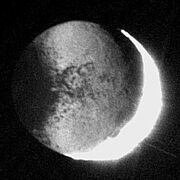
Saturn's moon Iapetus lit by Saturnshine. This is an enhanced picture; the Saturnlit is too faint to be visible to the unaided human eye.
The phenomenon known as planetshine occurs when reflected sunlight from a planet illuminates the dark side of one of its moons. Typically, this results in the moon's dark side being bathed in a soft, faint light. The best known example of planetshine is Earthshine, which can be seen from Earth when the Moon is a thin crescent. Planetshine has been observed elsewhere in the solar system, however; in particular it has recently been used by the Cassini space probe to image portions of the moons of Saturn even when they are not lit by the Sun.
Earthshine[]

Earthshine reflecting off the Moon. The bright region is directly illuminated by the sun, while the rest of the Moon is illuminated by light reflected off the Earth.

Leonardo da Vinci's sketch of crescent Moon with earthshine as part of his Codex Leicester, written between 1506 and 1510.
Earthshine is reflected Earthlight visible on the Moon's night side. It is also known as the Moon's ashen glow or as the old Moon in the new Moon's arms.
Earthshine is most readily observable shortly before and after a New Moon, during the waxing or waning crescent phase. When the Moon is new as viewed from Earth, the Earth is fully lit up as viewed from the Moon. Sunlight is reflected from the Earth to the night side of the Moon. The night side appears to glow faintly and the entire orb of the Moon is dimly visible.
Leonardo da Vinci explained the phenomenon in the early 1500s when he realized that both Earth and the Moon reflect sunlight. Light is reflected from the Earth to the Moon and back to the Earth as Earthshine.
Earthshine is used to help determine the current albedo of the Earth. The data are used to analyze global weather phenomena. Oceans reflect the least amount of light, roughly 10%. Land reflects anywhere from 10-25% of the Sun's light, and clouds reflect around 50%. So, the half of the Earth where it is daytime determines how bright the Moon's Earthshine appears at any given time.
Studies of Earthshine can be used to show how the Earth's cloud cover varies over time. Preliminary results show a 6.5% dip in cloud cover between 1985 and 1997 and a corresponding increase between 1997 and 2003. This has implications for climate research, especially with regards to global warming. Some clouds have a net warming effect because they trap heat, while others have a net cooling effect because they increase albedo, so the overall effect on global temperature remains unclear. [1]
See also: André-Louis Danjon, Danjon scale.
Search for terrestrial planets[]
Scientists at NASA's Navigator Program, which specialises in the detection of terrestrial planets, has backed the launch of a Terrestrial Planet Finder (TPF) mission.[2] TPF would detect "earthshine" from planets orbiting stars to investigate whether they could habour life. It would use advanced telescope technologies to look for life-marks in the light reflected from the planets, including water, oxygen and methane.
The European Space Agency has a similar mission, named Darwin, under consideration. This will also study the earthshine of planets to detect the signatures of life.[3]
The chief problem is developing technologies sensitive enough to detect the reflection of light from planet surfaces.
See also[]
- Ashen Light
External links[]
- Science@NASA: Earthshine
- NASA Astronomy Picture of the Day, 19 April 2002
- 'Earthshine' Linked to Solar Cycle, Climate Change, Space.com
- Scientists Watch Dark Side of the Moon to Monitor Earth's Climate, American Geophysical Union